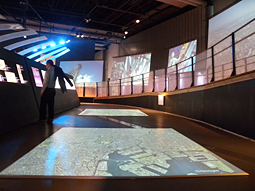 |
|
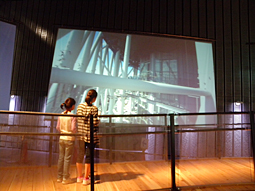 |
| Throughout the exhibition space, large screens draw visitors right into the construction site with both bird's-eye and fly-on-the-wall views. Even the floor of the gallery is used to dramatic effect. |
If you live in Japan and your family includes a school-age child, this behind-the-scenes look at the design, engineering, and construction of Tokyo Sky Tree offers plenty of interesting angles for all grades and learning styles -- especially now as conversations turn to the annual dilemma of what to investigate for those summer-vacation research assignments.
Slated for completion in February 2012 and a grand opening on May 22, Japan's tallest structure (and the world's tallest freestanding communications tower) took on new symbolic significance following the March 11 earthquake -- a point that was impressed on many when the tower's final height of 634 meters (2,080 feet) was reached exactly a week after the disaster struck. Meanwhile the National Museum of Emerging Science and Innovation (Miraikan, as it is better known) sustained enough damage in the quake to warrant a three-month closure for repairs -- making this exhibition the venue's first to be held since the disaster, and its focus on safety, teamwork, and the age-old quest to build higher all the more poignant. Curated with an upbeat emphasis on engineering prowess and ingenuity, and presented with a friendly, accessible vibe, Making of Tokyo Sky Tree delivers a hopeful message -- the power of dreaming -- that is only too welcome as Japan continues to grapple with the challenges of the post-disaster rebuilding effort.
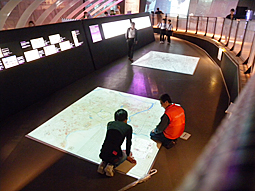 |
|
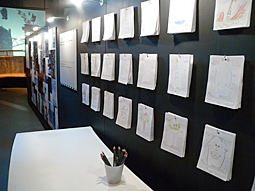 |
| Here, a volunteer staff member and visitor examine an 1856 map of the district where Tokyo Sky Tree now rises. A second floor panel displays changes in the area decade by decade from 1936. |
|
Doodle sheets and colored pencils are provided for visitors to dream up their own tower. Aspiring designers will appreciate the early-stage conceptual designs, models, and schematic diagrams also on display. |
The exhibition begins in the vast space beneath Miraikan's iconic spinning Earth display, where a life-sized construction crane is parked. If you (or any inquisitive children you know) have ever wondered how the last working crane at the top of a towering edifice is dismantled and lowered to the ground, you'll find the answer here. Elsewhere too, the actual machinery and new technologies developed to build Tokyo Sky Tree are introduced along with bilingual multimedia display panels that incorporate text, illustrations, and film footage so visitors of all bents and backgrounds can find something to ponder.
The route moves on to a zone created in collaboration with the Edo-Tokyo Museum, where historical maps and ukiyo-e images explore the spirit of craftsmanship in Tokyo's evolution from a low-rise city of wooden buildings to the high-rise megalopolis it is today. Subsequent sections examine Tokyo Sky Tree's development as seen from the architect and urban planner's desk; the realities of its construction site; and lastly, a futuristic view of urban design presented from a variety of professions and featuring a Lego-block city built by children around a 1:100 scale reproduction of the tower. Volunteers and museum staff are on hand throughout to answer questions, and the exhibits include live presentations as well as a vertigo-inducing 3-D film shot from the top of the tower and shown from within the cockpit of an actual tower crane, for added effect. For the inquisitively minded -- if not intrepid -- visitor, it's an engaging way to spend an hour or two or more.
 |
|
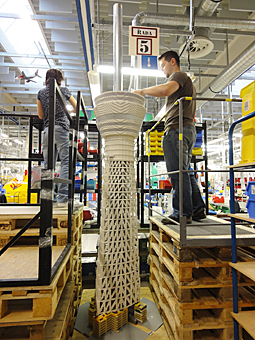 |
| Visitors can enter an actual crane cockpit like the white one pictured here, and experience this view viscerally with 3-D film footage. Photograph courtesy of Miraikan |
|
Lego builders in the Czech Republic spent 240 days drafting and building this 1:100 scale reproduction of Tokyo Sky Tree. Photograph courtesy of Miraikan |
For those who remain skeptical of the hoopla Tokyo Sky Tree has received in the press, the exhibition does reveal some impressive facts about its design. Triangular at its base, the tower gradually morphs into a circular shape as it rises -- a configuration that will treat future visitors to full 360-degree views from its two observation decks at 350 and 450 meters (1,148 and 1,476 feet). In terms of the tower's structural engineering, the architectural firm Nikken Sekkei has set some world precedents, most notably the creation of a new technology for vibration control. Sky Tree's central column -- a cylindrical shell which houses the staircase and is, at 375 meters or 1,230 feet, the longest concrete structure in all of Japan -- is structurally detached from the peripheral steel framing. This enables the column's upper part to function as a balancing weight, rather like the pendulum of a metronome, to offset sway induced by wind and tremors.
The exhibits also show how, in order to secure sufficient space for the antenna's assembly and avoid the risks associated with hoisting this massive device to its great height above the ground, it was pulled up internally through the tower's unfinished hollow core -- wherein it was assembled as well. (Comprised of six steel columns, the antenna measures 6 meters or 19.6 feet in diameter and is 165 meters or 541 feet long.) As the completed antenna slowly inched its way up to the top, the concrete for the tower's structural core was poured in after it, its formwork gradually sliding up the edifice -- another unprecedented engineering solution, the combined logistics of which really do stagger the mind. If your kids aren't amazed by this feat, you surely will be.
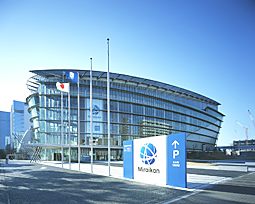 |
|
Near the waterfront in Tokyo's Odaiba district, Miraikan is easily accessible from the Yurikamome monorail and makes a fun and educational outing with kids of any age. Photograph courtesy of Miraikan
Unless otherwise noted, photographs are by Susan Rogers Chikuba, by permission of Miraikan.
|
|